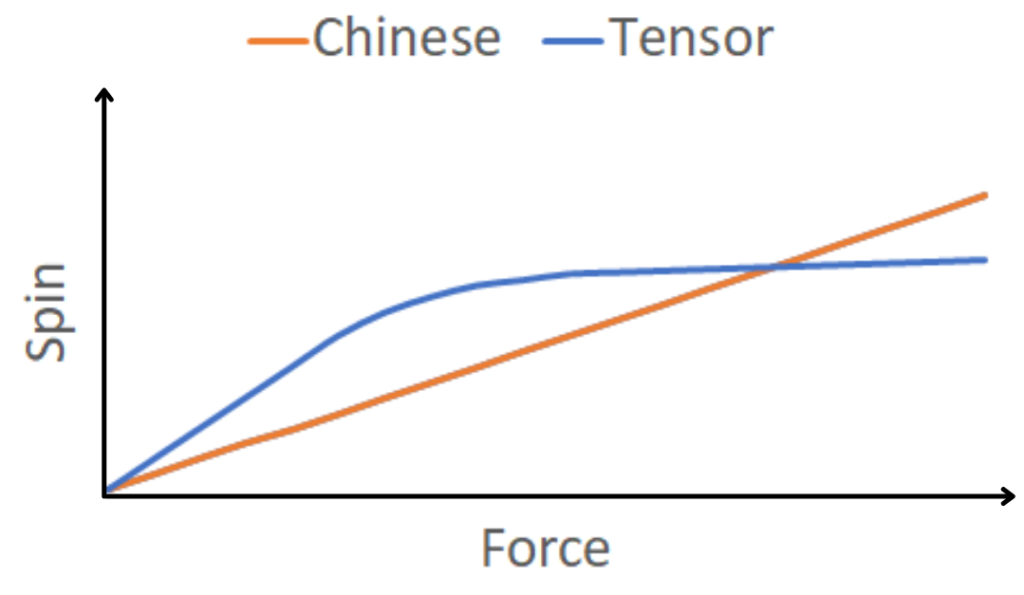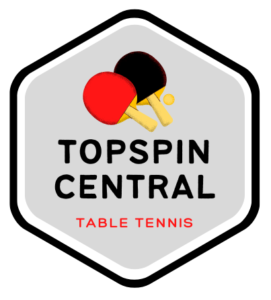Choosing between Chinese style and European/ Japanese style tensor rubber for a table tennis paddle is a very important decision because it massively effects how the ball responds to your movement. In this article, I’ll compare Chinese and European rubbers so you can decide which is the best option for you.
Chinese vs European Rubber
Chinese table tennis rubber is tackier than European tensor rubber. European rubber has a softer sponge so it will feel bouncier in comparison. Chinese rubber offers more spin potential, however it requires perfect technique whereas European tensor rubber makes it easier to apply spin.
Rubber Characteristics
First, let’s talk about the characteristics of each type of rubber so we can properly understand why it affects things like spin, throw angle and speed.
When you hear someone say “European” rubber, they are referring to “tensor” style rubber which is also known as “Japanese” style rubber
Chinese rubber is harder and tackier (sticker) compared to European/ Japanese tensor rubber which is bouncier and softer. Chinese rubber uses the tackiness of the rubber to generate spin, whereas tensor rubber uses softer sponge to make the rubber springier which increase the contact time with the ball to generate spin.
- Tacky Chinese rubber has more friction compared to tensor rubber
- Tensor rubber is softer and allows to the ball to sink into the paddle more than Chinese rubber
It’s these two differences that change how the ball responds to the paddle.

Applying Spin
The way Chinese and European rubbers apply spin to the ball is quite different.
- Chinese rubbers primarily generate spin when the ball essentially sticks to the tackier rubber allowing the stroke to apply spin to the ball when force is applied.
- European tensor rubbers generate spin when the ball sinks into the softer rubber, giving the paddle a longer contact time with the ball to generate spin.
In both cases, the amount of spin applied is heavily dependent on the contact paddle has with the ball, and the level of force applied. However, it’s important to remember that there are plenty of other variables to consider when applying spin which are related to your paddle and your technique. Here we are just talking about what would happen if you kept everything else the same.
So what difference does the way the spin is applied actually make on the level of spin applied.
Chinese rubbers allow you to apply more spin to the ball, however it is more difficult to actually apply the spin because it is very dependent on your technique. European rubbers do not generate as much spin, but they do make it easier for you to actually generate spin.
There’s an important distinction to make here: the maximum spin capability and the ease of generating the spin are two very separate things.
With Chinese rubber, the spin is generated by maintaining contact with the ball as you essentially brush it with the tacky rubber.
With European rubber, the spin is generated by maintaining contact with the ball as it sinks into the rubber. Again, the longer the contact is and the more force used, the more spin will be applied. However, you have less control over how long this contact time can be.
That’s why European rubber makes it easier to generate spin, because it’s less reliant on technique compared to Chinese rubber which actually has better spin capability. It’s why most amateurs will find it a lot easier to apply spin to the ball using tensor rubber compared to Chinese rubbers, but professional players will get more spin from Chinese rubber compared to tensor rubber.

Speed
Tensor rubbers generate speed because they have a bouncy feel to them so the ball springs off the paddle more quickly. Chinese rubbers require the player to use a full stroke to get maximum speed. Again, you get a similar relationship with speed as you do with spin.
Tensor rubbers feel softer and more springy and feel faster when you use less force, however, there is a limit to this relationship. Chinese rubber is harder and may feel slower when you use less force, however the maximum speed capability is higher.
- Tensor rubber generates more speed with less force
- Chinese rubber generates more speed with maximum force
For amateur players with a less forceful stroke, the tensor rubber will feel faster, however for a more experienced player with a faster and fuller stroke, the Chinese rubber will be faster.

Control
Rubbers have a control rating to indicate how easy the rubber is to play with and maintain proper control. The table below uses data from revspin.net which includes user ratings to compare different rubbers. As you can see, there’s really not much difference in the control rating between Chinese and European tensor rubbers.
Some players find European rubber easier to control because the sponge is softer, however others find that it can feel faster due to the bouncy characteristic which requires you to use a more delicate touch. There are a lot more variables going on here so it’s hard to assess which is better in terms of the control they offer, so it’s best to try them yourself and see which feels best to you.
| Rubber | Type | Control Rating |
| DHS NEO Hurricane 3 | Chinese | 8.6 |
| Friendship/ 729 Battle II | Chinese | 9.0 |
| Yinhe Big Dipper | Chinese | 8.4 |
| Sanwei Target National | Tensor (Euro) | 9.0 |
| Butterfly Tenergy 05 | Tensor (Euro) | 8.4 |
| JOOLA Rhyzm | Tensor (Euro) | 8.7 |
| XIOM Vega Europe | Tensor (Euro) | 9.1 |
Switching Rubber Types
It is often harder for a player to switch from European tensor style rubber to tacky Chinese rubber. To get the most spin out of Chinese rubber you will require very good technique, so many new players struggle when switching to Chinese rubber if their technique is lacking.
It is much easier for a player to switch from Chinese to European tensor rubber, however it’s rarely done because there is not much advantage. If a player has mastered their technique and is comfortable with tacky rubber, then switching to tensor rubber will often reduce the amount of spin they can generate.
If you are switching to Chinese rubber for the first time, you need to make sure you have good technique as otherwise your playing may actually become worse.
Even if you are a very capable player, you may still struggle with the transition at first but it’s a good idea to commit to it for at least a month before you consider moving back to tensor. This will give you enough time to decide if Chinese rubber is the best option for you.
Examples of Chinese and European Rubber
Many brands make Chinese and European/ Japanese tensor rubbers so it can be difficult to know which is which. Here are some examples of each:
Chinese Rubber:
- DHS Hurricane 3
- Friendship 729 Battle 2
- YINHE Big Dipper
- Sanwei Target National
European Rubber:
- Butterfly Tenergy
- JOOLA Rhyzm
- XIOM Vega Europe
- Donic Bluefire M2
Here are some more articles you might find useful:
